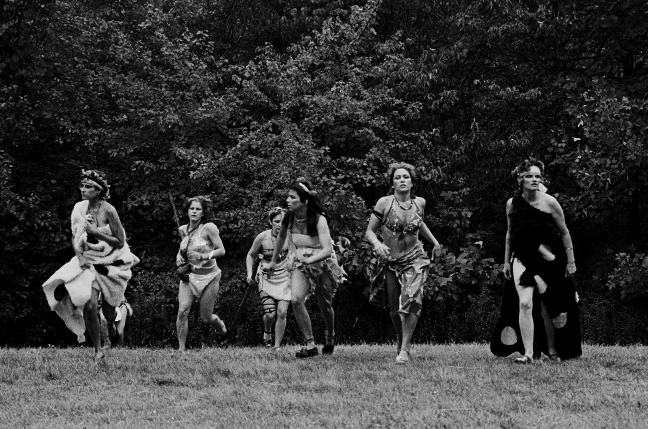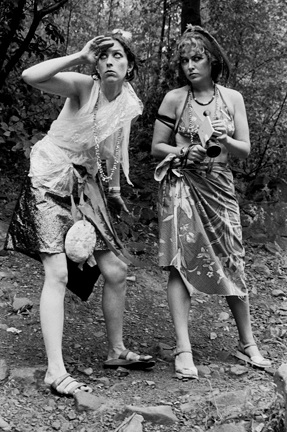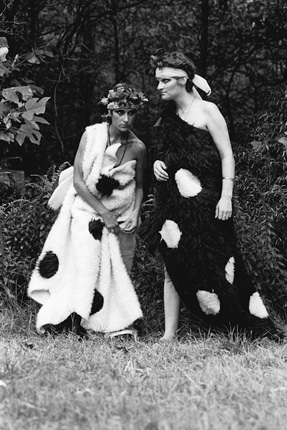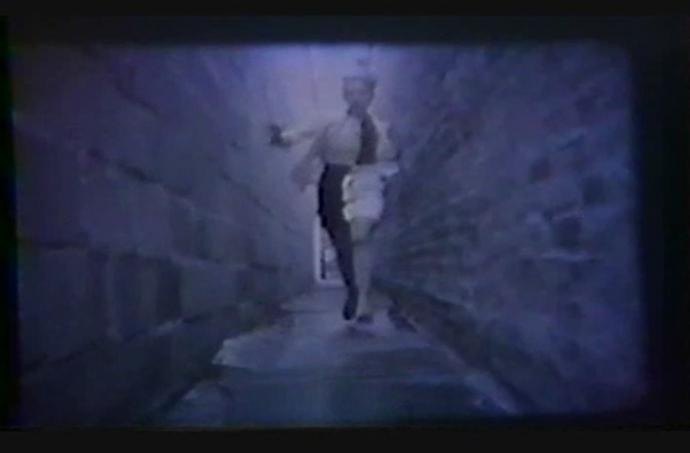from pastelegram.org, June 2011 – April 2014
Cave Girls and Worlds Without Men
Between 1980 and 1983, Kiki Smith and Ellen Cooper organized a group of fifteen women—most closely affiliated with the artists’ collective Collaborative Projects (Colab) and the Lower East Side's alternative art space ABC No Rio—in a video project entitled Cave Girls. Shot in super-8 film, Cave Girls reveals the discovery of a prehistoric tribe of women in South Orange, New Jersey. The first half of the video follows a team of researchers as they uncover an abundance of archaeological evidence, including videos, of this prehistoric female-only society. After constructing such an already tentative narrative held together by voiceovers, however, in the second half the thirty-minute work devolves into a montage of cave girl footage accompanied by post-punk music from the all-female bands Y Pants and Bush Tetras.
Since Cave Girls records the discovery and subsequent interpretation of what is, in fact, an invented archaeological site, the video investigates assumptions about the documentary genre while also questioning and critiquing the broader themes of documentation, evidence, authenticity and history. Operating within a complex cultural matrix following a heated decade of second-wave feminism, the video uses an imagined past to confront and address contemporary concerns of the 1980s woman. These women draw upon the motifs and beliefs of the earlier generation of feminists, but ultimately undercut the historical validity of the matriarchal myth through video parody. As a collaborative female-only project, Cave Girls represents an attempt at using video's form and content to present a new collective possibility for women; in making new histories, these women in turn make new communities.

Teri Slotkin, photograph of the Cave Girls (left to right: Marnie Greenholtz, Cara Brownell, Verge Piersol, Julie Harrison, Ellen Cooper, Bebe Smith); 1982; © Teri Slotkin Photography.
The account of the discovery and interpretation of archaeological artifacts from this prehistoric tribe of women is couched in academic language.1 The video opens with an explanation of the overall Cave Girls project, using authoritative words such as “Task Force,” “history department,” and “evidence” to establish its authenticity, seriousness and legitimacy. Throughout Cave Girls, the overarching narration relies upon pseudo-scientific language to legitimate the project—for instance, the narrator describes using “potassium-argon dating” to determine the age of the cave girls’ videos—while footage of machines, wires and books complement the pseudo-scientific discourse. The video also intersperses “archival” footage throughout. In grainy and nearly inscrutable black-and-white, this footage implies the effects of age and weathering and appears in marked contrast to the more intelligible color footage of the researchers at work. Here color represents contemporaneity, while the prehistoric footage appears temporally distant, factual and authentic.
Despite its documentary format, the video's mere premise—that prehistoric women from New Jersey made a collection of videos—immediately establishes it as a fake. Using pseudo-scientific language and visuals to establish “proof” and to analyze archaeological “data” and “evidence” of a fictitious culture, the women parody and satirize the very tools, languages and processes of legitimization used by archaeologists, scientists and documentarians.2 As a fake documentary, Cave Girls thus offers us an alternative to the dominant historical narrative by presenting an invented past as truth. By using fiction and invention, the video attests to the notion of history as constructed small fictions that create large historical truths.
Cave Girls's approach to history is directly rooted in the discourse of second-wave feminism, in full swing by the early 1980s. The exclusion of women from the dominant historical narratives was a concern at the forefront of feminist debates, and Cave Girls engages with this need to find a historical place and historical dialogue for women and critiquing the existing patriarchal structure of history.
The prehistoric era especially appealed to feminists because of the dearth of evidence and knowledge about its cultures. Within these prehistoric societies, feminists found utopic, communal possibilities, a point perhaps most evident in the matriarchal myth emerging in the 1970s.3 According to the matriarchal myth, from the Paleolithic era until sometime around 3000 BCE, human society was matriarchal and goddess-worshipping.4 This theory meant not only the possibility of a female-dominated world, but it also marked the beginnings of patriarchy about five thousand years ago.5 As Cynthia Eller demonstrates in her book The Myth of Matriarchal Prehistory, however, there is no archaeological evidence that prehistoric societies were definitively matriarchal, goddess-worshipping or even sexually egalitarian.6 Despite the lack of evidence, the power of imagining a matriarchal past proved quite useful and even necessary for feminists seeking an alternative to society's patriarchal structure.

Cover of Heresies; "Great Goddess" issue, Spring 1978.
The lack of archaeological evidence certainly did not deter feminists from believing in the matriarchal myths, as mythological themes swept feminist literature and the art world. For instance, the feminist magazine Heresies devoted its Spring 1978 issue to the “Great Goddess;” it became the magazine's best-selling issue.7 At the same time, feminist artists drawing upon the “Great Goddess” myth inundated the art world. Artists such as Nancy Spero and Yolanda M. Lopez drew upon the iconography of goddesses to counter the dominating male figure of “God.” Mary Beth Edelson performed Your Five Thousand Years Are Up! in La Jolla, California in 1977, celebrating women's rebirth and the termination of patriarchy's long reign over women. A few years later artist Buffie Johnson published Lady of the Beasts: Ancient Images of the Goddess and Her Sacred Animals (1981).
In Cave Girls, evidence does exist to prove the existence of cave girls. The recently discovered artifacts are endowed with magical powers and reach from their historic depths to touch those who originally discovered the archaeological site. The video tells how on July 24, 1976 while on a Girl Scout outing, little Fiona Templeton found a strange-looking cassette tape with a “drawing of a hand with a strange ultraviolet light that radiated from the fingertips.” When she and her friends played the tape, they felt their “hands and toes begin to tingle. They were energized by the music. When it was over, they ran back to the waterfall where they found it and began searching in the brush. Their energy seemed boundless as they lifted large rocks easily.” The cassette, or perhaps it was the discovery of this new historical knowledge, literally provided them with super-human strength. Once they learned of one prehistoric story, the girls went in search for more; the hunger for more knowledge of past women grew, as did their physical and communal strength.
Regardless of the metaphor of communality presented in Cave Girls, the video also shows a younger generation of women struggling with the previous generation's invention of a mythological “herstory.” The video becomes a parody of these beliefs in the matriarchal myth. There is no attempt to disguise the distance between the prehistoric cave girls and the 1980s archaeologists. The cave girls wear 1980s clothing, such as leopard-print leggings and leotards, directly aligning the past with the present. This not-so-subtle alignment is further emphasized by the fact that the same women who perform as scientists also appear as cave girls. By deliberately and playfully faking this history, the video reveals a troubled relationship between this group of women and their generational predecessors. While earlier artists and feminists such as Mary Beth Edelson and Susan Rothenberg found genuine value in turning to a prehistoric past, the creators of Cave Girls respond to this tradition by critically parodying this search for an invented history and thereby aiming to create a contemporary community rather than a distant one.


Teri Slotkin, production photograph of Cave Girls (1982); left: filmmakers Kiki SMith and Ellen Cooper, right: Cave Girls Marnie Greenholtz and Bebe Smith; © Teri Slotkin Photography.
Cave Girls constructs, or rather deconstructs, a historical myth, but on a more practical level it creates space for women within the medium's discourse. Collaborator Kiki Smith notes in an interview that there are “10 billion men's films that are about men only. Cave Girls is about women in a group.”8 Not only does the video function to “document” the lost historical presence of women, but it also serves to document the presence of women videographers in 1980s New York City. Significantly, their collaboration in the production of this endeavor actually mimics that of the prehistoric society they envision: a world without men and one in which women support, nurture, and survive with one another.9 According to Kiki Smith, “Everybody's got a vision of Cave Girls, of making your own myth, making your own history.”10 This multiplicity mostly emerges in the film's various juxtapositions of images and narratives. The purpose of the collaboration, and a larger theme of the video, is partly “how to recognize yourself as a band, a group of people, and the power you have as part of that group.”11 Those involved in the production realized the benefits of community and creating dialogue for the feminist cause.


Kiki Smith, Ellen Cooper and others; Cave Girls, 1982; television show.
The video itself complicates the presumed temporal distance between the prehistoric cave girl and the 1980s woman. Cave Girls plays with the relationship between the past and present by presenting scenes of contemporary women in urban environments in black-and-white film, which are then juxtaposed with the fabricated black-and-white archival footage of cave girls. For example, a black-and-white scene in which a chic, urban woman runs down a narrow alley toward the camera immediately precedes footage of a prehistoric woman. Despite the connotations of black and white’s “pastness,” these juxtapositions offer a temporal collapse between the past and present, suggesting not only that modern women can be cave girls, too, but that the urban landscape has replaced the lush untapped nature of the cave girls’ world. The modern woman has a new environment she must confront and in which she must survive. The similarities or parallels between the cave girls and the modern woman become even clearer when some of the researchers question the supposed distance between the prehistoric women and themselves. One notes the haunting presence of the past in her consciousness: “I hear a sound that carries in the distance a drumbeat. Shadows on the wall appear as someone moving. I look up and it's gone. I have the feeling of being followed, but I turn and no one is there.” Here the past is like a ghost that lingers and follows the present, even if that history is unwritten, as the narrator suggests, due to the patriarchal structure of history, society and its media outlets:
The media has obscured and suppressed these phenomena from us. There is a growing sense among women that more information about them is a vital necessity. We must find out. Know what they knew! Present culture has created a split from them. It has dissipated our sexual power. Everywhere, we are harassed on the streets and in our homes. We are split from each other divided by competition and jealousy. The situation is chaotic. We need new forms, new structures of thinking before any of this can improve. We must employ any possible means toward this end.
This type of dialogue in the video suggests that such power structures have prevented female camaraderie and support because such collectivity may present a danger to them. Therefore, uncovering or inventing women's historical significance can perhaps lead to new models of female bonding that could have existed before the dominance of patriarchy.
Entirely consumed by their search for the prehistoric cave girls, the researchers eventually come to physically occupy their world, dressed in togas and 1980s animal-print clothes. Any semblance of a narrative dissipates as music by the Y Pants and Bush Tetras replaces the narrator's voice. This last segment—filmed in soft, pale colors that suggest the absorption of the black-and-white historical footage (i.e., the past) with the colorful 1980s footage (i.e., the present)—represents the final creation of a utopic female-only world. Through the enlightenment of their archaeological research, the scientists have been able to merge their present selves with this past world in order to discover these “new forms, new structures of thinking.”
At the very end the video jumps to what appears to be a production studio, shattering any lingering illusion of a true documentary form. The crew, wearing headphones and pink tie-dyed shirts that say “Cave Girls,” stands behind a dancer wearing feathers in her hair, a brightly sequined skirt and a bikini top. She stands amidst bright studio lights, wires and a closed-circuit video monitor. The dancer's presence amidst these obvious signs of modernity reveals the video’s constructed nature and exposes the entire production as a performance. Though this final moment overtly reveals the production process, it still emphasizes the community of the videographers gathered in the studio, who collaborated on the project. Even if the prehistoric tribe of women never existed, perhaps they do or can exist now.
- 1. One may also note the relationship of photography and video to the fields of anthropology and ethnography to record and study members of various societies.
- 2. In their book F is for Phony, Alexandra Juhasz and Jesse Lerner argue that fake documentaries question the serious documentary genre as representative of truth by “reminding us that much of what we may want to see or know is undocumented, unspoken, disallowed, mistranslated, misremembered, and misrepresented. From Alexandra Juhasz and Jesse Lerner, F is for Phony: Fake Documentary and Truth’s Undoing (Minneapolis: University of Minnesota, 2006): 14-15.
- 3. The publication of Helen Diner’s Mothers and Amazons: The First Feminine History of Culture in 1973 and Marija Gimbuta’s The Gods and Goddesses of Old Europe in 1974 contributed to the growing “Great Goddess” movement. In addition to the “Great Goddess” myth, the Amazon myth also frequently appeared in the 1970s, which attests to the need for female-centered communalities and collaborations. Perhaps most prominently attesting to this desire was the popularity of Wonder Woman in the 1970s. She became a powerful figure for female liberation, as her sexual difference was the source of her power. In fact, the feminist Gloria Steinem put Wonder Woman on the cover of the first issue of Ms. Magazine in July 1972 with the caption, “Wonder Woman for President.” Wonder Woman’s origin myth centered on Paradise Island, “a man-free homeland for Amazon women who developed their bodies, minds, and social relationships free from any controlling masculine influence.” (See Andi Zeisler, Feminism and Pop Culture (Berkeley: Seal, 2008), 77). The Wonder Woman myth emphasizes the centrality of a woman-only community to her female power. In addition, Charlotte Perkins Gilman's early feminist tale from 1915 of a utopic, advanced Amazonian society, Herland, was republished for the first time in 1979. The themes of Wonder Woman and Herland suggest the need for a total escape from an androcentric worldview, but also a desire for community and collectivity.
- 4. Cynthia Eller, The Myth of Matriarchal Prehistory: Why an Invented Past Won’t Give Women a Future (Boston: Beacon, 2000), 2-3.
- 5. Considering the origins of patriarchy, feminist Gloria Steinem noted in 1972: “Once upon a time, the many cultures of this world were all part of the gynocratic age. . . . The discovery of paternity, of sexual cause and childbirth effect, was as cataclysmic for society as, say the discovery of fire or the shattering of an atom. . . Gynocracy also suffered from the periodic invasions of nomadic tribes. . . . [W]omen gradually lost their freedom, mystery, and superior position. For five thousand years or more, the gynocratic age had flowered in peace and productivity. Slowly, in varying stages and in different parts of the world, the social order was painfully reversed. Women became the underclass, marked by their visible differences.” (Quoted in Eller, 1-2).
- 6. Eller also explains that “the theory that prehistory was matriarchal and goddess-worshipping is presented as fact, not fiction. It is only omitted from standard history texts, feminist matriarchalists say, because academics are trapped in a patriarchal worldview, suffering the consequences of a huge cover-up of matriarchy that started with the patriarchal revolution and has continued right up to the present” (13). Again, we see a blurring of the space between historical fact and historical fiction used to serve the feminist struggle in the 1970s.
- 7. Simon Taylor, “The Women’s Artists’ Movement: From Radical to Cultural Feminism, 1969 -1975,” in Personal and Political: The Women’s Art Movement, 1969-1975 (East Hampton, NY: Guild Hall Museum, 2002), 22-23.
- 8. Karyn Kay, “From Poofo to Cave Girls: An Interview with Ellen Cooper and Kiki Smith,” Framework 21 (Summer 1983): 28.
- 9. In fact, on the VHS's case the credits read “No stars,” instead of “Starring,” listing the names of the contributors one after the other in no apparent hierarchical order.
- 10. Kay, 28.
- 11. Kay, 30.